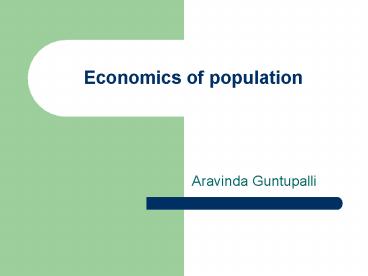Economics of population - PowerPoint PPT Presentation
1 / 36
Title:
Economics of population
Description:
About 60% of the population lives in Asia and Oceania ... Archeological data. Terms used. Fertility. Mortality. Migration. Age structure ... – PowerPoint PPT presentation
Number of Views:167
Avg rating:3.0/5.0
Title: Economics of population
1
Economics of population
- Aravinda Guntupalli
2
Facts on world population
- Total world population 6.1 billion
- About 75 of people live in developing countries
- About 60 of the population lives in Asia and
Oceania - About 40 of people live in only 15 countries
- By 2200, over 90 of population will live in what
today are developing countries
3
(No Transcript)
4
Topics
- Demographic measures
- Issues of population growth
- Population growth in the world
- Past
- Present
- Theories of population
5
Demographic measures
- Birthrate
- Death rate
- Rate of natural increase
- Life expectancy at birth
- Dependency ratio
- Median age of the population
6
Where is the data coming from?
- Census
- Vital statistics
- Surveys
- Parish records
- Archeological data
7
Terms used
- Fertility
- Mortality
- Migration
- Age structure
8
Components of population
Population in 2004 Births Deaths
Immigrants Emigrants --------------------------
Population in 2004
- Natural increase births-deaths
- Net migration Immigrants-emigrants
9
Issues of population economics
- Dependency population
- Infrastructure
- Availability of resources
- Ageing
- Old age support
- Inequality
- Savings and consumption
- HIV/AIDS
10
Contrasting problems
- Different parts of the world face different
problems with regard to population growth. - Many countries are struggling to decrease
population whereas some are in the hope to
increase their population
11
Dependency problems
- Old age structures and young age structures both
create problems with supporting dependents they
are just different problems. - Young age structure requires expanding labor
markets, investments in education - Investments in older people less likely to
enhance productivity
12
(No Transcript)
13
(No Transcript)
14
Population decline and economic growth
- Reduction in birthrates can raise per-capita
income in 2 ways - lower dependency ratio
- low consumption and high savings
- Shift of labor force investment from capital
widening to capital deepening
15
Ageing and economic burden in the EU
- The process of ageing is putting European social
services under considerable stress - Old age expenditure (as a of GDP) has risen
significantly since the 1980s and remained stable
during much of the 1990s - Old age expenditure represents two fifths of all
social expenditure (highest incidence in Italy,
Greece, and Spain)
16
Percentage of elderly in the EU and US
17
(No Transcript)
18
(No Transcript)
19
(No Transcript)
20
(No Transcript)
21
(No Transcript)
22
Population Growth, 1750-2200 World, Less
Developed Regions, and More Developed Regions
23
(No Transcript)
24
Population Pyramids Less Developed and More
Developed Countries 1998
25
(No Transcript)
26
(No Transcript)
27
(No Transcript)
28
(No Transcript)
29
(No Transcript)
30
Malthusian population model
- Population tends to grow at a geometric rate,
doubling every 30 to 40 years - Food supplies only expand at an arithmetic rate
due to diminishing returns to land (fixed factor) - Malthusian population trap countries would be
trapped in low per-capita incomes (per capita
food), and population would stabilize at a
subsistence level. - Preventive and positive checks
- Technological progress is not considered
31
The Demographic Transition
- Stage I birthrates and death rates are close and
high - Stage II continued high birthrates, declining
death rates - Stage III falling birthrates to reach death
rates - Stage IV both birth and death rates are close
again and low
32
Demographic transition
33
The present demographic transition in developing
countries
- Stage II already occurred in most of the
developing world,but with higher birthrates than
in the developed world. - Stage III
- has been similar to developed countries for
some developing countries like Taiwan, South
Korea, China,Chile, Costa Rica - has not occurred yet for other countries mainly
in Sub-Saharan Africa and the middle east.
34
Rapid and Slow Transition
- Rapid transition
- Japan
- South Korea
- Taiwan
- Singapore
- Thailand
- Indonesia
- Slow Transition
- Pakistan
- India
- Bangladesh
- Philippines
- Papua New Guinea
35
Miracles of rapid transition in East Asia
- Rapid demographic change creates windows
- of opportunity for accelerated economic growth
- Rapid growth of labor force
- Saving and investment
- Changing roles of women
- Human resource investment
36
- Thank You































